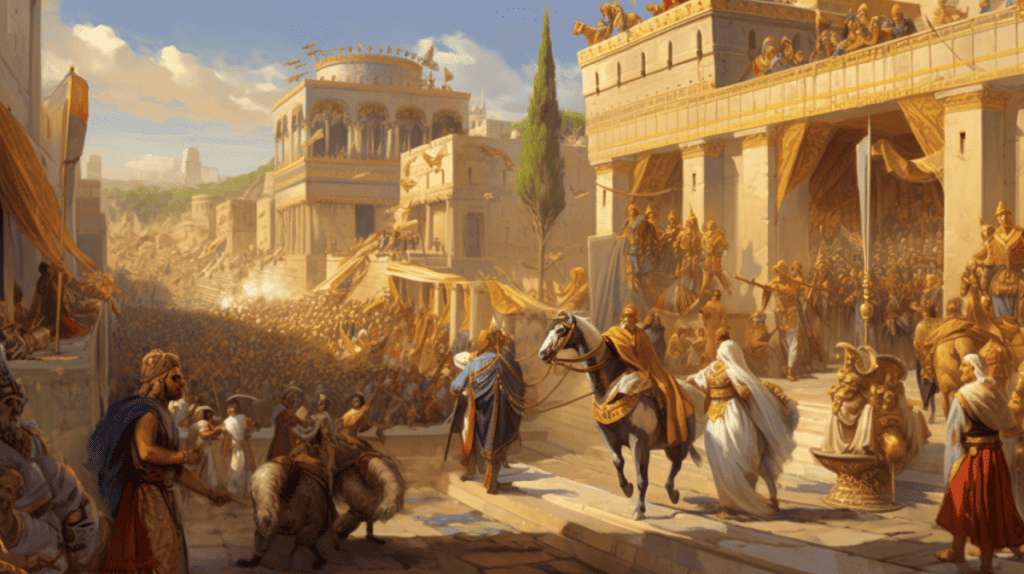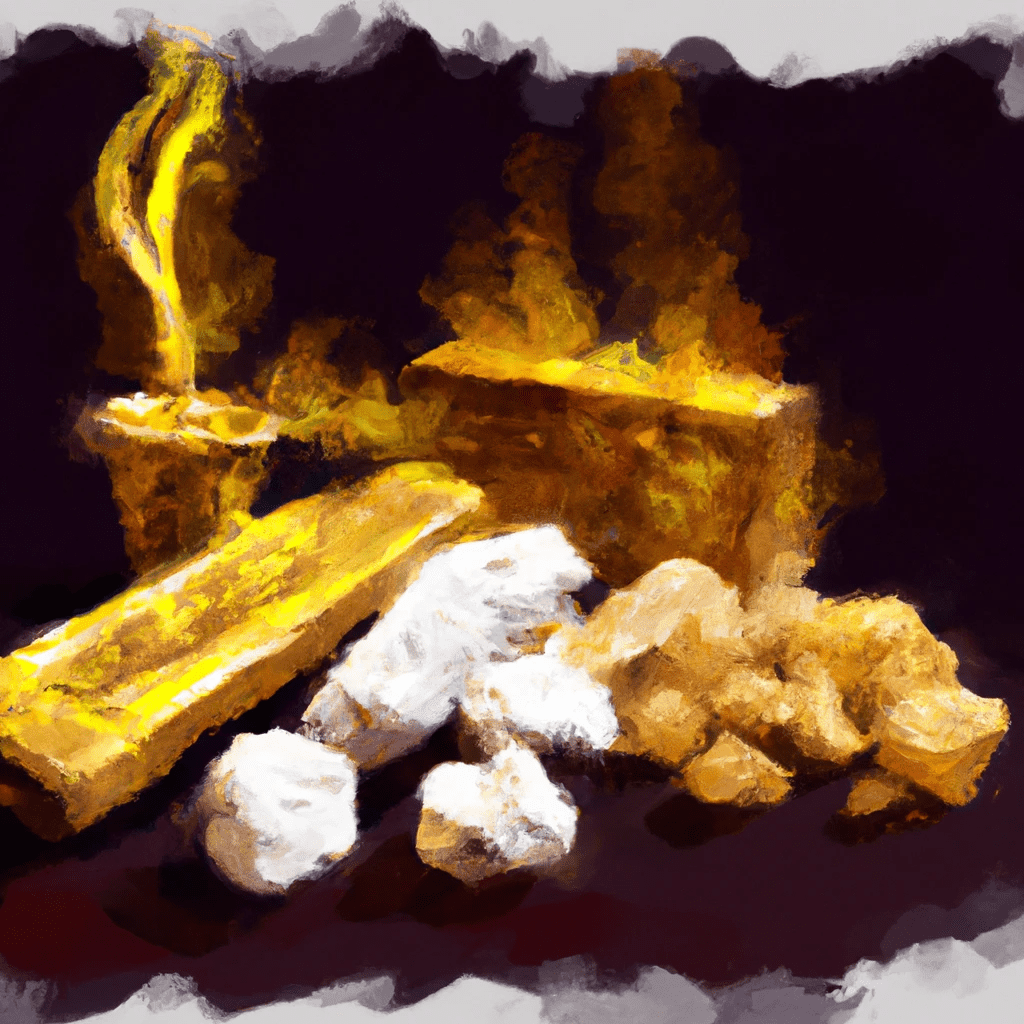The Queen of Sheba, ruling in today’s Yemen and Ethiopia, is renowned for her visit to King Solomon in Jerusalem. Mentioned in both the Bible and Quran, their iconic meeting blends politics and legend, influencing art and stories for centuries.
In the sacred scriptures of Kings and Chronicles, an intriguing narrative unfurls featuring King Solomon and the Queen of Sheba. A mysterious queen, hailing from the enigmatic land of Sheba, embarks on a journey to Jerusalem laden with treasures of gold, gems, and spices. Intrigued by the famed wisdom of Solomon, this intellectually curious queen throws forth a series of challenging questions. Solomon, in his sagacity, successfully answers her riddles, showering her with generous hospitality which is reciprocated with gifts.

“Such a profusion of spices was never brought in as those gifted by the Queen of Sheba to Solomon.” Later on, she commends him, “Your wisdom and wealth surpass even the rumours I had heard.” (1 Kings 10:7).
This historical encounter has sparked an array of themes in the realm of popular culture, including beauty, opulence, power, exotic allure, mystery, magic, and romance. The enigmatic queen has been an inspiration for Turkish and Persian miniatures, European art and music, and even the 1959 Hollywood blockbuster ‘Solomon and Sheba’, featuring Yul Brynner as the sage king and Gina Lollobrigida as his equally captivating counterpart.
This profound biblical story has fueled numerous interpretations and adaptations, thanks to the rich literary tradition that sprang from it. An intriguing reference to this encounter can be found in the writings of the first-century A.D. Roman Jewish author, Flavius Josephus. The Quran, compiled in the seventh century, presents an even more elaborate version of this story, closely mirrored in Jewish rabbinic literature. The ‘Kebra Nagast’, a 14th-century Ethiopian Christian epic, ties the Queen of Sheba to the inception of Ethiopia itself, locating ancient Sheba within Ethiopia. The queen and Solomon supposedly have a son who establishes a dynasty that rules Ethiopia until the last of his lineage, Haile Selassie, passes away in 1975. (Let’s consider what archaeology reveals about King Solomon’s mines.)
Despite extensive research, no definitive archaeological evidence has surfaced that can conclusively identify the queen or trace her roots. She could be a composite of historical figures or purely a figment of legend. The exact location of Sheba is also a bone of contention among scholars, with some leaning towards Ethiopia, and others favouring the ancient kingdom of Saba in present-day Yemen.
Wealth and Enigmas
Amidst wealth and riddles, the biblical portrayal of the Queen of Sheba paints her as intelligent, self-reliant, challenging, and respectful. Flavius Josephus, in his first-century A.D. historical work, ‘The Antiquities of the Jews’, depicts Sheba as a seeker of philosophy and someone to be admired on multiple fronts.
As the tale evolved and reemerged in the Targum Sheni, a Jewish narrative from around the seventh to eighth centuries A.D., it had taken on added layers of mystique. The essence of the story remained consistent, yet it commenced with an incredible account of a chattering hoopoe – a feather-crested bird indigenous to the region. This bird shared with Solomon a surprising truth: Sheba was the sole earthly land not under his dominion.
Taking matters into his own hands, Solomon dispatched the hoopoe back to Sheba, carrying a letter that pleaded with the queen to succumb to his rule. Undaunted, the queen responded with a flotilla filled to the brim with magnificent gifts, including 6,000 young men of identical height, all clothed in purple, and all born on the same day, at the same hour. These men were the queen’s messengers, announcing her impending visit to Jerusalem.

Upon her grand arrival, the Queen of Sheba presented Solomon with three enigmatic riddles, which he answered with ease. This intellectual exchange allowed her to assess Solomon’s wisdom, demonstrating her own cunning and diplomatic prowess. For her, these riddles were more than mere amusement; they were a strategic tool.
However, the historical timeline of the Targum Sheni is disputed. Some academics speculate that the Quran’s rendition of the tale borrows from the Targum Sheni. Yet, given the uncertainty of the Targum Sheni’s exact creation date, it’s plausible that the Quran’s narrative, crafted in the seventh century, influenced the Jewish text instead.
In the Quranic version, the queen, named Bilqis in contemporary Arabic sources, is a powerful ruler whose people venerate the sun. A bird informs Suleiman (Solomon), known for his wisdom and spiritual connection to Allah, of Bilqis and her sun-worshipping kingdom. This provokes Suleiman to send a letter urging the queen to embrace Islam.
Rather than accepting the queen’s envoys and their luxurious gifts, Suleiman challenges the queen’s intellect. As she journeyed to meet him, he tasked a jinn to pilfer her throne and bring it to Jerusalem. In a test of recognition, he disguised the throne to see if the queen would identify it. Upon successfully recognizing her throne, Suleiman warmly received Bilqis in his opulent palace.
The tale takes a turn when Suleiman unveils a glass floor to Bilqis, which she mistakes for a pool of water. Thinking to avoid wetting her skirts, she lifts them, revealing her unshaven legs. Modern feminist interpreters have suggested that this feature is an indication of her power rendering her less feminine. This same narrative also appears in the Targum Sheni.
In both Jewish and Islamic texts, the queen has been associated with the demonic figure, Lilith. A jinn warns Suleiman of the queen’s potentially perilous beauty. Regardless, the queen yields to Solomon and dedicates herself to “Allah, the Lord of all worlds.”
The Matriarch of a Kingdom
Venturing further into the tale’s evolution, it garnered fresh significance in the 14th century within the northern highlands of Africa’s Horn—today’s Ethiopia, Eritrea, Somalia, and Djibouti. In this narrative, the queen earned a new name: Makeda. A blend of Christian, Jewish, and Muslim traditions led to the formation of an entirely unique version of the story.
Christianity began to permeate the Kingdom of Aksum (now part of modern Ethiopia) around the mid-500s A.D. Alongside Jewish influences, these teachings arrived through waves of migration and trade with the northern people, including Egypt’s Coptic Christians. The story of Solomon and Queen Makeda materialized in writing in 1321 in the Kebra Nagast, an Ethiopian saga which served to unify Ethiopian culture for centuries.

In Pursuit of Sheba’s Reality
The enigmatic domain of Sheba has yet to be definitively located. The prime candidates are the Kingdom of Saba in present-day Yemen and the ancient Kingdom of Aksum in Ethiopia. Despite efforts to unearth solid archaeological evidence, the mystery remains. The timeline attributed to Solomon, mostly considered to be around the 10th century B.C., fails to align with the flourishing periods of either Saba or Aksum.
Emerging theories propose fresh perspectives on the queen’s origins. For instance, Wendy Laura Belcher, a professor of African literature at Princeton University, suggests that the queen might hail from an entirely different culture: the pre-Aksumite Ethiopian civilisation of Punt. Mentioned in Egyptian sources as far back as the 15th century B.C., Punt furnished Egypt with luxuries like incense, spices, and gold, all associated with the queen’s renowned visit to Solomon. As the debate continues, the world patiently awaits the next twist in the ongoing quest to uncover the real Queen of Sheba.

Related Posts
Sources
“Where Did the Queen of Sheba Rule: Arabia or Africa?” National Geographic. Last modified June 2021. https://www.nationalgeographic.co.uk/history-and-civilisation/2021/06/where-did-the-queen-of-sheba-rule-arabia-or-africa.




